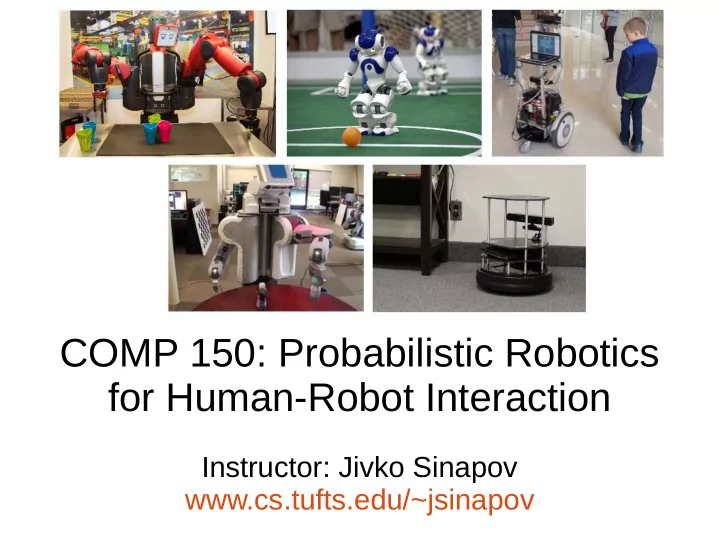

COMP 150: Probabilistic Robotics for Human-Robot Interaction Instructor: Jivko Sinapov www.cs.tufts.edu/~jsinapov
Today ● Homework 1 hints ● Introduction for Particle Filters for localization
Localization and Mapping
Robot Maps [https://www.pirobot.org/blog/0015/map-1b.png]
Robot Maps [http://www.openrobots.org/morse/doc/1.2/user/advanced_tutorials/ros_nav_tutorial.html]
Robot Maps [https://raw.githubusercontent.com/wiki/introlab/rtabmap/doc/IROS-Kinect-Challenge/combined.png]
Robot Maps [http://rrt.fh-wels.at/images/sites/fancybox/3d_mapping.jpg]
Robot Maps
A Simple 1-D Map
A Simple 1-D Map How would we represent this map using math?
A Simple 1-D Map At t = 1, our robot receives an observation:
A Simple 1-D Map At t = 1, our robot receives an observation: bel(x) x
A Simple 1-D Map At t = 1, our robot receives an observation: bel(x) x
A Simple 1-D Map At t = 1, our robot receives an observation: bel(x) x
A Simple 1-D Map At t = 1, our robot receives an observation: bel(x) x
A Simple 1-D Map At t = 1, our robot receives an observation: bel(x) x
A Simple 1-D Map At t = 1, our robot receives an observation: Clearly, a single Gaussian is insufficient to represent our belief that we may be at either of the 3 doors with equal probability bel(x) x
A Simple 1-D Map At t = 1, our robot receives an observation: Clearly, a single Gaussian is insufficient to represent our belief that we may be at either of the 3 doors with equal probability What if we had an initial estimate of the robot’s location prior to observing and moving? bel(x) x
But what if we don’t know where we are at the start? Or, what if somebody moves the robot manually after it started its operation?
Odometry “Odometry is the use of data from motion sensors to estimate change in position over time. It is used in robotics by some legged or wheeled robots to estimate their position relative to a starting location. This method is sensitive to errors due to the integration of velocity measurements over time to give position estimates. “
Odometry Errors
Basic idea behind Particle Filters x
Now, in 2-D [http://www.ite.uni-karlsruhe.de/METZGER/DIPLOMARBEITEN/dipl2.html]
Robot Pose
Odometry Motion Model
Sampling from the Model
Motion Model
Velocity Models with Different Parameters
Velocity Models with Different Parameters
Example
Initially, we do not know the location of the robot, so the particles are everywhere
Next, the robot sees a door
Therefore, we inflate particles next to a door and shrink the rest
Therefore, we inflate particles next to a door and shrink the rest
Computing the weights p(z 1 |x 1 ) x 1 Before x 1 After x 1
Before, we continue we re-sample our particles to make them all the same size
Before, we continue we re-sample our particles to make them all the same size
Resampling Rules = = =
Resampling • Given : Set S of weighted samples. • Wanted : Random sample, where the probability of drawing x i is given by w i . • Typically done n times with replacement to generate new sample set S’ .
Roulette wheel Resampling w 1 w n w 1 w n w 2 w 2 W n-1 W n-1 w 3 w 3 • Stochastic universal sampling • Roulette wheel • Systematic resampling • Binary search, n log n • Linear time complexity • Easy to implement, low variance [From Thrun’s book “Probabilistic Robotics”]
Next, the robot moves to the right...
Therefore, we have to shift the particles to the right as well
Therefore, we have to shift the particles to the right as well
...and add some position noise
...and add some position noise
Next, the robot senses that is next to a door
Next, the robot senses that is next to a door
…we resample again
The robot keeps going to the right...
...we shift the particles again
...and we add noise.
And so on...
Now, let’s compare that to some of the other methods
Grid Localization
Markov Localization
KF
Particle Filter
Examples
Localizing using Sonar
73
74
75
76
77
78
Using Ceiling Maps
Vision-Based Localization P(z|x) z h(x)
Under a light Measurement z: P(z|x) :
Close to a light Measurement z: P(z|x) :
Far from a light Measurement z: P(z|x) :
Could the robot use both vision and sonar to localize? How?
Summary Particle filters are an implementation of recursive Bayesian filtering They represent the posterior by a set of weighted samples. In the context of localization, the particles are propagated according to the motion model. They are then weighted according to the likelihood of the observations. In a re-sampling step, new particles are drawn with a probability proportional to the likelihood of the observation.
Localization and Mapping Project Ideas ● Build maps and localize using vision ● 2D and/or 3D vision ● Ceiling Maps ● Incorporate multiple sources of observations for computing p(z1,z2,…,zk|x) ● Integrate existing mapping and localization algorithms into the turtlebot2 code-base
Credits ● Some slides adapted / borrowed from: Alexander Stoytchev Sebastian Thrun
THE END
89
90
Recommend
More recommend